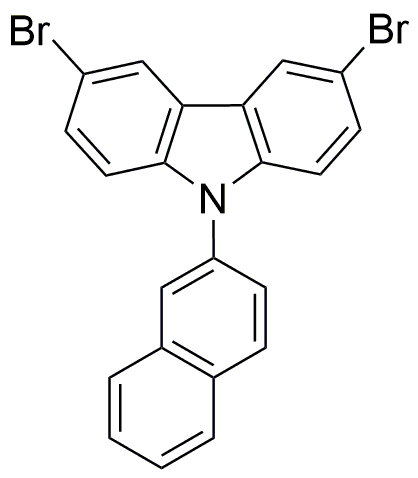3,6-Dibromo-9-(2-naphthalenyl)-9H-carbazole is widely utilized in research focused on:
- Organic Electronics: This compound is used in the development of organic light-emitting diodes (OLEDs) due to its excellent luminescent properties, enhancing display technologies in smartphones and televisions.
- Photovoltaic Cells: It serves as a key material in organic solar cells, improving energy conversion efficiency and contributing to sustainable energy solutions.
- Fluorescent Sensors: The compound is effective in creating fluorescent sensors for detecting environmental pollutants, aiding in environmental monitoring and protection.
- Biomedical Applications: Its unique properties make it suitable for use in drug delivery systems, where it can improve the targeting and efficacy of therapeutic agents.
- Research in Material Science: This chemical is valuable in the study of new materials for electronic applications, helping researchers innovate and develop next-generation technologies.
General Information
Properties
Safety and Regulations
Applications
3,6-Dibromo-9-(2-naphthalenyl)-9H-carbazole is widely utilized in research focused on:
- Organic Electronics: This compound is used in the development of organic light-emitting diodes (OLEDs) due to its excellent luminescent properties, enhancing display technologies in smartphones and televisions.
- Photovoltaic Cells: It serves as a key material in organic solar cells, improving energy conversion efficiency and contributing to sustainable energy solutions.
- Fluorescent Sensors: The compound is effective in creating fluorescent sensors for detecting environmental pollutants, aiding in environmental monitoring and protection.
- Biomedical Applications: Its unique properties make it suitable for use in drug delivery systems, where it can improve the targeting and efficacy of therapeutic agents.
- Research in Material Science: This chemical is valuable in the study of new materials for electronic applications, helping researchers innovate and develop next-generation technologies.
Documents
Safety Data Sheets (SDS)
The SDS provides comprehensive safety information on handling, storage, and disposal of the product.
Product Specification (PS)
The PS provides a comprehensive breakdown of the product’s properties, including chemical composition, physical state, purity, and storage requirements. It also details acceptable quality ranges and the product's intended applications.
Certificates of Analysis (COA)
Search for Certificates of Analysis (COA) by entering the products Lot Number. Lot and Batch Numbers can be found on a product’s label following the words ‘Lot’ or ‘Batch’.
Número de catálogo
Número de lote/lote
Certificates Of Origin (COO)
This COO confirms the country where the product was manufactured, and also details the materials and components used in it and whether it is derived from natural, synthetic, or other specific sources. This certificate may be required for customs, trade, and regulatory compliance.
Número de catálogo
Número de lote/lote
Safety Data Sheets (SDS)
The SDS provides comprehensive safety information on handling, storage, and disposal of the product.
DownloadProduct Specification (PS)
The PS provides a comprehensive breakdown of the product’s properties, including chemical composition, physical state, purity, and storage requirements. It also details acceptable quality ranges and the product's intended applications.
DownloadCertificates of Analysis (COA)
Search for Certificates of Analysis (COA) by entering the products Lot Number. Lot and Batch Numbers can be found on a product’s label following the words ‘Lot’ or ‘Batch’.
Número de catálogo
Número de lote/lote
Certificates Of Origin (COO)
This COO confirms the country where the product was manufactured, and also details the materials and components used in it and whether it is derived from natural, synthetic, or other specific sources. This certificate may be required for customs, trade, and regulatory compliance.


